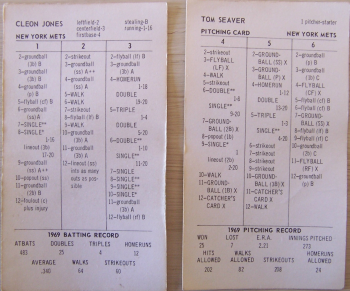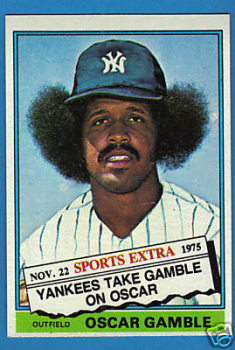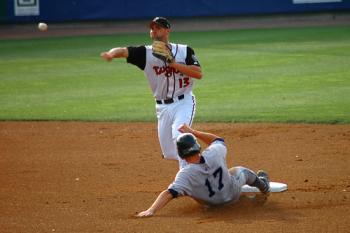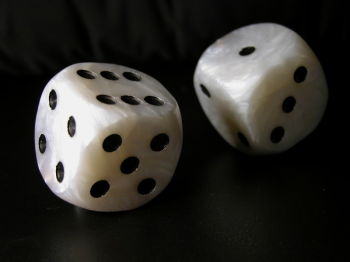Strat-O-Matic and the Baseball Tarot: Sense and Synchronicity in Sports and Games
Ted Friedman / Georgia State University – Atlanta

My last column addressed the role of game studies in media studies. In this column, I’d like to dig deeper into game analysis by looking at the role of chance in gameplay.
Thirty years ago, over the summer between fourth and fifth grades, I fell in love with a game called Strat-O-Matic Baseball.1 In Strat, every player is represented by a cardboard card listing three columns full of possible results of an at bat. For each at bat, you roll three dice – one red and two white – and look up the results on the players’ cards. For 1-3 on the red, you look on the batter’s card, for 4-6 the pitcher’s. You total the two white dice to determine where down the column you find the result.
The game held many pleasures: the fantasy of control over the ballplayers, the social interaction with the kids with whom I played games and swapped cards, the tactile thrill of holding the cards and rolling the dice. But at the core was my fascination with the game’s numbers. The combination of three dice led to 216 possible outcomes. (6x6x6). That meant you had 1 in 216 chance of rolling, say, a 1-12 (often resulting in a player injury, the duration of which was determined by generating another random number), and a 6 in 216 chance of rolling a 3-7 (since, as in craps, 6 different combinations of white dice would total 7). I quickly memorized the odds of each combination (aided by a chart I found in a book on Monopoly2 ), and learned to add up the probabilities on each player’s card at a glance.
Learning these probabilities gave me a sense of mastery over these cardboard ballplayers, which compensated for my limitations on the physical ball field. Through junior high, I grew fairly obsessed with Strat. In addition to playing with friends, I would organize solitaire all-star games, tournaments, and simulated leagues. I once reran the 1979 New York Yankees season to see how it might have turned out if the great platoon lefty slugger Oscar Gamble, who was acquired at midseason, had played for them all year, every day. (They won the pennant.)

Strat also introduced me to the quantitative study of baseball pioneered by Bill James – a movement which would go on to revolutionize the way the game today is played, managed, and enjoyed. The worldview of sabermetrics (a term derived from SABR, the Society of American Baseball Research) celebrated rational inquiry, empirical research, and skepticism for the received wisdom of the baseball establishment. James regularly published research suggesting that such shibboleths as batting order protection and clutch hitting were simply old managers’ tales.3 Reading Bill James and playing Strat-O-Matic made me feel like one of the cognoscenti who understood how baseball really worked.
Strat-O-Matic reifies the complexity of a real-life game of baseball. It takes all the messiness of a social institution involving the interactions of 18 players and thousands of fans in a three-dimensional physical space, and boils it down to dice and cardboard. Left out is the poetry of the double-play pivot, the smell of the grass, and everything else that can’t fit into a box score.

That’s OK. That’s what games do: they’re forms of “world reduction,” simulations designed to model and interpret a more complex whole.4 Baseball itself is already world reduction, reducing human interaction to a series of balls and strikes, outs and runs, winners and losers. Strat just takes that minimalism one step further.
But what I’ve come to recognize is that in my romance with mathematical rationality, I had repressed my attraction to the other half of Strat-O-Matic’s – and almost all games’ – allure: the role of random chance. I carefully collated my statistics, ran my percentages – then played the game by rolling dice, over and over. Where reason ended and luck began was exactly where work became play. It was chance which produced the excitement of the games – the improbable rallies, the no-hitters, the walk-off home runs.

What sparked the return of this repressed thought was something I found in a New Age bookstore recently: The Baseball Tarot.5 Tarot cards, one might think, are the antithesis of what the sabermetrician stands for: pure superstition, untethered to any system of rational logic. Yet, I couldn’t get over the similarities between my Strat cards and that Tarot deck, which replaces the traditional Rider-Waite cards such as the Fool, the Hierophant, and the World with baseball equivalents the Rookie, the Manager, and the World Series. The accompanying book offers alternatives to the traditional Celtic Cross layout such as, you guessed it, the baseball diamond.


The Tarot works through what Carl Jung called synchronicity: the tendency of the mind to find meaning in apparent coincidence.6 The reader shuffles the cards, lays them out, then relies on the juxtaposition of archetypal images to stir unpredictable associations out of the unconscious and into consciousness. It’s the same alchemy explored by William S. Burroughs in his “cut-up” experiments in randomly generated prose, and by John Cage in his compositions produced through throws of the I Ching. And it’s what produces meaning in any game involving chance, including not only Strat-O-Matic but real-life sports as well, which so often turn on luck as much as skill.
Sports and games are story-generating machines. Out of a series of unpredictable moments spins an idiosyncratic narrative, familiar in its shape yet different every time, thanks to the role of chance. Once each tale has been told, we can’t help but ascribe the result to more than luck, because narrative always produces meaning.
The sabermetrician in me likes to think that I know how to separate skill from luck: to treat skill as signal, and luck as noise. But the narratologist in me recognizes that I’ve had it backwards. All that statistical analysis just allows me to rationalize and compartmentalize my fascination with synchronicity. That tarot deck forced me to recognize that playing Strat-O-Matic, all along, had been a form of divination.
Image Credits:
1. Strat-O-Matic Cards
2. Oscar Gamble
3. Slide
4. Dice
5. The Fool
6. The Rookie
Please feel free to comment.
- For a history of Strat, see Glenn Guzzo, Strat-O-Matic Fanatics (Skokie, IL: ACTA Sports, 2005) [↩]
- I’m pretty sure it was Maxine Brady, Monopoly Book: Strategy and Tactics of the World’s Most Popular Game (New York: Pan Macmillan, 1980) [↩]
- For a good overview of his research, see Bill James, This Time Let’s Not Eat the Bones: Bill James Without the Numbers (New York: Villard, 1989). For an overview of James’s influence on the game, see Gregory F. Augustine Pierce, ed., How Bill James Changed Our View of the Game of Baseball (Skokie, IL: ACTA Sports, 2007). See also Ted Friedman, “Bill James on Clutch Hitting” [↩]
- I’m borrowing the phrase “world reduction” from Fredric Jameson’s essay, “World Reduction in Le Guin: The Emergence of Utopian Narrative,” Science Fiction Studies 7 (November 1975): 23-39. Jameson is spinning off the concept in science fiction and fantasy of “world building” to describe the creation of elaborate alternate universes with rich back stories. For more on world reduction, see Ted Friedman, Electric Dreams: Computers in American Culture (New York: New York University Press, 2005), 154-7 [↩]
- Mark Lerner and Laura Phillips, The Baseball Tarot: Book & Card Set. (New York: Workman Publishing Company, 1999) [↩]
- Carl Jung, Synchronicity: An Acausal Connecting Principle. (Princeton, NJ: Princeton University Press, 1973). See also Maria von Franz, Divination and Synchronicity: The Psychology of Meaningful Chance. (Toronto, ON: Inner City Books, 1980) [↩]
Again, a very well-written article, wonderfully paced and spun into a satisfying narrative.
While I certainly never heard of Strat-O-Matic cards, the general argument of this column, that chance should not be forgotten in any formulation of gameplay, is a valuable idea to keep in mind. If this is the first meditation on chance within the field of game studies, it is indeed an important piece. Most importantly, though, you continue to provide an analysis of gameplay that is both fun to read and informative, and you present this week’s lesson about chance in an accessible and clear manner.
I guess the pressing question to me is, then, how is chance discussed in the field of game studies? And would you say it is not enough, and is that, perhaps, the catalyst for this column?
This is a fantastic example of the type of topics that Flow can open up for discussion — great column, Ted.
Provocative piece, Ted, for a rhetorician such as myself who is what may be considered slightly obsessed with baseball simulations. First, I want to ask if you’ve read Robert Coover’s “The Universal Baseball Association, Inc., J. Henry Waugh, Prop.”? It’s novelistic meta-fiction at its finest, telling the tale of a lonely accountant whose world is his baseball dice game. Instead of like the author of this column, who manipulated and then replayed actual baseball seasons, the accountant creates a fictional universe and assigns values (it is not a coincidence that “J Henry Waugh” is so far off from Yahweh). The accountant goes further and actually creates a league office with an imaginary commissioner; the novel itself hinges on the 1 in 1,000,000 dice-roll wherein an all-star player is beaned in the head and tragically dies (it’s happened once in Major League history, in the early 20th century–before helmets).
Now, for my question: I never got into the cards/dice games, but, as a product of the cpu age, got interested in baseball sims in the 90s when apba bbw, baseball mogul, and diamond mind, etc, were coming out. What I’m wondering is if/how computer baseball sims erase the rational/logical sequences in the game play? As a player, we do not see the mathematical permutations being run. The roll of the dice is but an instantaneous mouse click, and a litany of player stats and skill-sets are stored for us.
I guess I’m curious how computer baseball sims affect the narratology/sabermetric debate that Ted interrogates.
Best Regards,
Zac Gershberg, PhD
Visiting Assistant Professor of Rhetoric
The University of Montana
Dept of Communication Studies
301 LA
Missoula, MT 59812
406-243-4551
z.gershberg@umontana.edu
@Daniel: Chance merits short discussion in such works as Salen and Zimmerman’s Rules of Play and Brian Sutton-Smith’s The Ambiguity of Play. That’s not surprising: for scholars interested in raising the profile of game studies and game design, the role of luck in gaming is something of an embarassment. The project of Salen and Zimmerman is to demonstrate that games aren’t just frivolous pastimes, but can produce “meaningful play.” Randomness raises the spectre of meaningless play. That leads both Salen & Zimmerman and Sutton-Smith to briskly conclude that the significance of randomness in gaming is to evoke the role of fate, then move on. I want to turn this around and suggest that dumb luck is at the irrational, unrepresentable, shameful core of how games produce meaning, and that much of the rest of our gaming pleasure is about alternately evading and surreptitiously exploring this repressed kernel of what Lacan and Zizek would call “the Real.” After all, since arbitrary mutations are what drive natural selection, in a sense randomness is the fundamental “primal scene.” I’m using Lacanian language here, but I think Jung’s concept of “synchronicity” is even more valuable for identifying how we can’t help but derive meaning from randomness. (This is part of a larger project of rethinking the value of Jung for cultural studies, about which I hope to have more to say in a future column.)
@Zac: I’m a huge fan of the Coover novel. Actually, I first read it in college, and its portrait of solitaire gaming as obsessive solipsism hit so close to home that I went home for spring break and threw away most of my Strat-O-Matic cards. (Years later, I bought back many of them.) Re: the invisible dice rolls in computer gaming, I think that’s a perfect example of how the irrational core of gaming is repressed in a technocractic culture that valorizes logic and reason, yet can’t quench its thirst for chance.
I had never heard of strat baseball before I read this article and now I’m intrigued with it. I played baseball as a kid, and I’ve been reminiscing about those days a lot recently. It’s by chance that I stumbled across this article at this time in my life. As a broke college student in the midst of the recession in the United States, any form of entertainment that is practical and inexpensive is crucial to survival and sanity. Especially when this entertainment can be enjoyed with friends. I’m stoked. My friends are into sports too, and not just that, but also enjoyment of risk taking and chance. Which almost can automatically be assumed, because those are aspects of any game, sports included. For example, if you’re not the kind of person that’s into taking risks, on the most basic level of winning or loosing, then you’re probably not into sports. On the other hand if risk is a big part of life, much enjoyment comes from chance. So much that it can even become an addiction, i.e. gambling. Taking chances can be enjoyable even if the results aren’t what you hoped for, because excitement can come out of each individual chance, obviously more with those that you hoped for.
I like to think of many things in my life as a “roll of the dice.”
One of my favorite mottos is “Play the hand you’re dealt,” as if the combination of, parents, location, economic status, and so-forth, were just different cards played together to the best potential. Its a good thing we can trade in a card here or there to make our hand stronger. Here’s when chance comes into play, the new card added to your hand isn’t always a good one.
Life, in minimalist mindset, is the combination of these different hands played and the choices made along the way.
Stinging these events together is creating the story of life.
The passage in your article that stood out to me most was’
“Sports and games are story-generating machines. Out of a series of unpredictable moments spins an idiosyncratic narrative, familiar in its shape yet different every time, thanks to the role of chance. Once each tale has been told, we can’t help but ascribe the result to more than luck, because narrative always produces meaning.”
The narrative life creates, seems to be spun together by a series of unpredictable moments shaping us all in familiar ways but at the same time sometimes completely different.
Recently I was in an economics of the arts class and risk was a big subject. Those who earn the most wealth, in this case the “Superstar” artists, leave a lot up to chance and take big risks. Logically thinking there is obviously skill involved, but pure skill doesn’t necessarily mean success. The rest is up to the “roll of the dice.” Whether its Connections made, people met, locations visited, or simply the right investments, there is definitely chance involved.
The most exciting parts of life seem to be those that are unpredictable in nature. Apply as much logic and reasoning as you can and certain things in life still just can’t be predicted. Take dating for example, girls are defiantly one of the most exiting things in my life, and there is no way you can logically reason how to find one thats comfortably compatible. Which reminds me of Eddie Murphy’s “Raw” stand up comedy show when he compares dating to rolling dice: got one you can’t deal with? better roll again ha.
Bringing it back to the simple game of Strat, after you explained the simple but great pleasures to me, I’ve come to realize why this game seems so inciting to me. It’s hard to explain why a good roll feels good, but its the same as getting a good hit, making a good deal with a friend, or buying something that you know is going to be a good investment. These scenarios in life are obviously bigger, and therefore involve more time invested. With a simple game, only so much time needs to be invested, but yet the psychological value can be as high as a bigger investment. Though when investing bigger, there is a chance of higher highs, and inevitably lower lows. Take for example the “Superstars” in, lets say, the music business. Some of these artists risked there whole lives on becoming famous. While the stars are gathering wealth, there are skilled artists scraping for pennies, and for many of the famous ones it was just a roll of the dice or two that made the difference.
You’re comparison of Strat to Tarot cards is genius. The mysterious knowledge Tarot can seem to spark gives me faith that all the risk in our life isn’t completely left up to chance. I believe everything in life happens for a reason, whether it’s “the path of God” or whatever you please, the world seems to work all to well for there to be no divine power at work. Synchronicity. Take for example, me running across this article at a time when I needed it most and learning about this dice game of baseball. I chose to take the risk of spending my time on this website and the roll was in my favor. Sometimes in life it seems like the best “rolls” seem to come at the times most needed, and the worst ones seem to teach the best lessons, but good or bad its all about the experience.
Reading your article helped me articulate these realizations, and though you may not agree with all of it, I chose to share. My thoughts on your article are not as structured and well written as yours, but I tried to express the broader aspects of chance and some ideology in my head that I’ve ended up with from the chronicle of my life thus far.
If I had a thesis to all this it would go something like; Just like the game created in Strat-O-Matic baseball or the draw of the Tarot, the story of our lives is divinely molded by chance in a familiar structure with an unexplainable series of unpredictable events.
I really enjoyed reading your article and thinking about it much more and deeper. Not to mention my discovery of a baseball game I can play with my friends, inside, with some dice and some cards.
Thanks Ted.
Friedmen tastefully uses sweet nostalgia in his childhood memories of the game Strat-O-Matic to hit on the bittersweet point that even when we try to control life, as he did by playing the game and “controlling” the baseball players, and trying to control the odds with probability,
the outcomes we experience in life are very much up to luck and chance. He links this thought into the practice of tarot cards, which in theory divine the future for believers, but seems to just be luck of the draw to the human eye. Yet Friedman also concludes that while the outcome may be just be a result of chance, the process to get there becomes its own narrative, giving the actions more meaning, and building up so that the conclusion has more meaning than just leaving it to luck and chance.
Dear Mr. Friedman:
I have been playing Strat O Matic for years. I fail to see the connection between Tarot cards and Strat O Matic. Could you explain again please how you believe the two are connected. Thank you for your time.
Mark
Mark –
Both Strat-O-Matic and the Tarot use random chance to generate meaning. In Tarot, you shuffle cards to produce a layout; in Strat, you roll dice to produce a ballgame. Most Strat players like to think of the random element of the game as a necessary evil, and emphasize the significance of players’ statistics and managers’ skill. Tarot users, on the other hand, embrace the role of chance. But I think chance has more to do with the pleasure of Strat than players want to admit. We repress the pleasure of randomness because it doesn’t fit our scientific worldview, but that’s exactly what makes it an alluring taboo. Try as we might, we can’t help being fascinated with what Jung calls synchronicity.
— Ted
Ted:
I played Strat O Matic from 1965 through 1970. One year, I played what amounted to 1/2 of an American League season, while my brother played 1/2 of a National League season. I am fascinated by your comparison of Strat to Tarot.
I am now a therapist (with a Jungian bent) and have written two books, one about Field of Dreams ( called “If You Build It”) and the synchronicity involved in the story.
I am 1/2 way through a book about synchronicity in “real” baseball. One chapter centers upon the Chicago Cubs, the “loser” archetype, and the amazing synchronicity that involved Steve Bartman (Bart Man…Bart Simpson), a real life representation of the Trickster.
I am convinced that synchronicity plays a decided role in big league baseball, especially during playoffs, World Series, and when players are pursuing personal goals. I believe heightened passion plays a role in their occurrrence.
Pingback: Centaur Manifesto | TedFriedman.com
Bonjour à vous ! Avez vous démarché une agence de référencement naturel pour le référencement internet ?
Hello Ted !
I glimpsed a photo of Carl Jung (~1937) with the New York Yankees sitting in a group-circle on the infield grass. The motivational poster was titled ‘Anticipation.’ The caption said that the team was in a hitting slump, and Jung was asked to speak to the players. He said (approx) “When in the on-deck circle, focus on your swing and warming up your body. Consider the possibility that your anticipation of getting a hit might actually be sharpening the abilitiies of the other team to stop you from achieving your goal.”
Of all places, I saw this in a Skymall catalog on a flight 7 or 8 years ago. All searches, internet and otherwise, have been fruitless. This includes contacting the Jung Institute in SF to find a copy of the 1937 Jung treatise “Baseball and the Unconscious” which was referenced in Gordon McAlpine’s book “Joy in Mudville.” I thought that this un-locate-able treatise would provide some clues.
Even the librarian at the SF Jung Institute offered no information.
Have I given enough clues to find the print/poster with Jung and the Yankees in the middle of a hitting slump?
any help and luck at this point would be welcome.
-L. Simcik